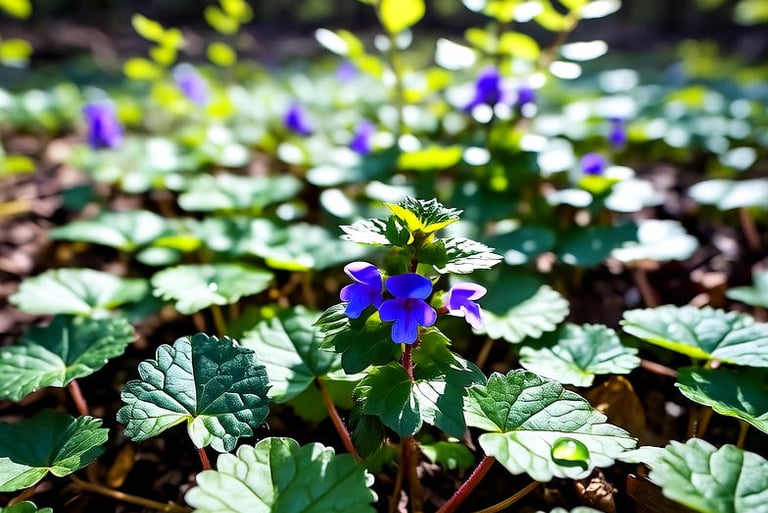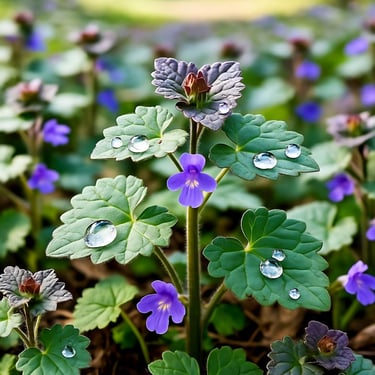Unlock the Power of Ground Ivy: The Backyard Herb That's a Natural Powerhouse
Have you ever spotted a low-growing plant with heart-shaped leaves and tiny purple flowers creeping across your lawn or garden? That's ground ivy (Glechoma hederacea), often dismissed as a pesky weed but cherished in herbal traditions for centuries. Also called creeping Charlie, gill-over-the-ground, or alehoof, this member of the mint family has a mild, minty aroma with a hint of bitterness. Native to Europe and Asia but now widespread in North America, it's been used since ancient times for everything from flavoring beer to treating ailments.
COLD AND FLURESPIRATORY SYSTEMRECIPES
10/27/20254 min read


Have you ever spotted a low-growing plant with heart-shaped leaves and tiny purple flowers creeping across your lawn or garden? That's ground ivy (Glechoma hederacea), often dismissed as a pesky weed but cherished in herbal traditions for centuries. Also called creeping Charlie, gill-over-the-ground, or alehoof, this member of the mint family has a mild, minty aroma with a hint of bitterness. Native to Europe and Asia but now widespread in North America, it's been used since ancient times for everything from flavoring beer to treating ailments. In this post, we'll dive into its impressive health benefits, backed by science, plus practical ways to use it safely. Whether you're a foraging newbie or a herbal enthusiast, ground ivy might just become your new go-to remedy.
Top 10 Health Benefits of Ground Ivy
Ground ivy is packed with bioactive compounds like polyphenols, flavonoids, and phenolic acids, which contribute to its therapeutic potential. Here are the top 10 benefits, each explained with how it works:
Antioxidant Protection: Ground ivy's polyphenolic compounds neutralize free radicals, reducing oxidative stress that can lead to chronic diseases. Studies show its extracts have strong antioxidant activity, helping protect cells from damage.
Anti-Inflammatory Effects: It inhibits inflammation pathways, making it useful for conditions like arthritis or skin issues. Research confirms its ability to reduce inflammation markers in lab tests.
Antibacterial Action: The herb fights bacteria by disrupting their cell walls, thanks to compounds like rosmarinic acid. Antimicrobial studies highlight its effectiveness against various bacterial strains.
Antiviral Properties: Ground ivy can inhibit viral replication, potentially aiding in fighting infections like influenza. Animal studies demonstrate enhanced antiviral effects when combined with other treatments.
Respiratory Support: Traditionally used for coughs and lung issues, it acts as an expectorant to clear mucus. Its astringent and anti-inflammatory qualities soothe respiratory tracts.
Anticancer Potential: Flavonoids in ground ivy may slow cancer cell growth in preliminary lab research, though more human studies are needed.
Skin Health Improvement: It reduces pigmentation and inflammation, making it a natural remedy for skin conditions. Modern research supports its use in reducing hyperpigmentation.
Joint Pain Relief: By easing inflammation, it helps with joint discomfort and swelling, as noted in traditional uses and backed by anti-inflammatory studies.
Nutrient Boost: Rich in minerals like potassium and calcium, it can serve as a natural supplement when consumed as an herbal product.
Antifungal Benefits: Extracts show activity against fungi like Candida, due to its bioactive components.
Powerful Effects on Viral and Bacterial Infections
Ground ivy's standout feature is its antimicrobial prowess against viruses and bacteria, rooted in its rich polyphenolic content, including rosmarinic acid and flavonoids. For bacterial infections, studies reveal that extracts disrupt bacterial biofilms and inhibit growth of pathogens like Staphylococcus and E. coli, with potent antibacterial activity confirmed in lab settings. On the viral front, research shows it enhances antiviral responses, such as against influenza, by boosting immune mechanisms when co-administered with antivirals like oseltamivir in mouse models. In vitro studies also demonstrate its ability to inhibit viral entry and replication, attributed to phenolic compounds that interfere with viral enzymes. These effects make it a promising natural adjunct for infections, though it's not a substitute for medical treatment.
How to Take Ground Ivy and Recommended Dosages
Ground ivy can be consumed as tea, tincture, or fresh in food. Always start low and consult a healthcare provider, especially if you have health conditions.
Tea: Steep 1-2 teaspoons of dried leaves in hot water for 10 minutes.
Tincture: Alcohol extract for concentrated use.
Fresh: Add to salads or recipes for mild flavor.
Adult Dosages: 2-4 grams of dried herb per day, or 2-4 ml tincture (1:1 ratio) three times daily. For tea, 1-3 cups daily.
Children Dosages: Adjust by age/weight. For 1-6 years: 1/3 adult dose; 7-12 years: 1/2 adult dose; under 1 year: 1/10 adult dose. Use tincture sparingly, like 1/5 dropper for a 30-pound child.
To deepen understanding, note its historical use in beer brewing (hence "alehoof") for flavor and preservation, leveraging its antimicrobial properties. It's also vitamin C-rich, supporting immune health.
3 Delicious Recipes Using Ground Ivy
Incorporate this herb into meals for a minty twist. Here are three easy recipes:
1. Ground Ivy Tea
A simple infusion for daily wellness.
Ingredients: 1-2 tsp fresh or dried ground ivy leaves, 1 cup hot water, honey (optional).
Steps:
Rinse fresh leaves or measure dried ones.
Place in a mug and pour hot (not boiling) water over them.
Steep for 10-15 minutes.
Strain, add honey if desired, and sip warm.
2. Ground Ivy Potato Salad
A fresh, foraged side dish.
Ingredients: 4 potatoes (boiled and cubed), 1/2 cup chopped ground ivy leaves, 1/4 cup mayo, 1 tbsp mustard, salt/pepper, optional veggies like onion or celery.
Steps:
Boil potatoes until tender, cool, and cube.
Chop ground ivy finely.
Mix mayo, mustard, salt, and pepper in a bowl.
Toss potatoes and ground ivy with dressing; chill for 1 hour before serving.
3. Ground Ivy, Butternut Squash, and Bacon Quiche
A savory pie with herbal depth.
Ingredients: 1 pie crust, 1 cup cubed butternut squash (roasted), 4 slices bacon (cooked and crumbled), 1/4 cup chopped ground ivy, 4 eggs, 1 cup milk, 1/2 cup cheese, salt/pepper.
Steps:
Preheat oven to 375°F (190°C); place pie crust in pan.
Roast squash cubes for 20 minutes until soft.
Whisk eggs, milk, salt, and pepper.
Layer squash, bacon, ground ivy, and cheese in crust; pour egg mixture over.
Bake 35-40 minutes until set; cool slightly before slicing.
Dangers, Precautions, and Concerns for Adults and Children
While generally safe in moderate amounts, ground ivy contains substances like pulegone that can harm the liver in high doses. Adults may experience gastrointestinal upset, like nausea or colic, if overconsumed. It's possibly toxic to the liver and unsafe during pregnancy, as it may cause miscarriage. For children, use lower doses and monitor for allergies; avoid in infants due to lack of safety data. Topical use might cause skin irritation like itching. It's toxic to horses, but human studies show mild toxicity only in excess. Precautions: Avoid if pregnant, breastfeeding, or with liver issues; no known drug interactions, but consult a doctor. Always forage from clean areas to avoid contaminants.
43 web pages




